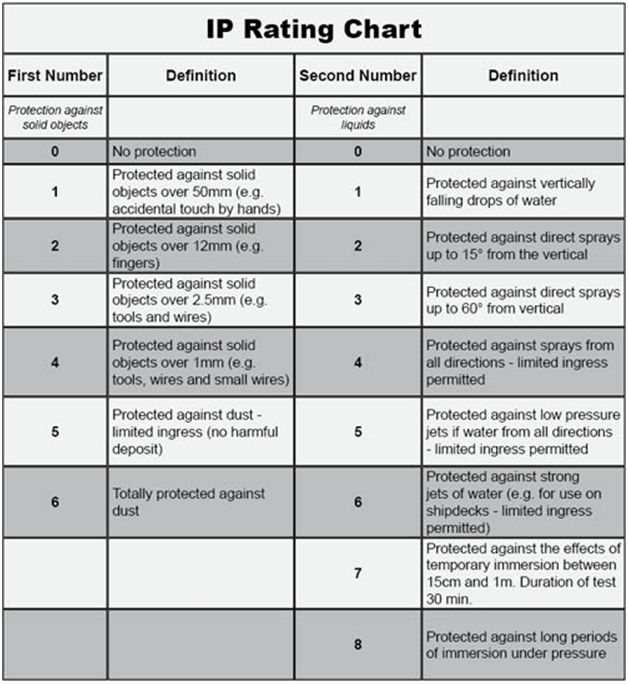MIL-STD Rating and IP Ratings
The MIL-STD rating is a set of standards developed by the United States Department of Defense (DoD) to ensure that military equipment can perform in harsh and extreme environments. These standards cover a wide range of testing, including environmental tests for temperature, humidity, altitude, and vibration, as well as electromagnetic interference and compatibility (EMI/EMC) testing, and others.
The MIL-STD rating is used to evaluate equipment used by the military, including electronic devices, vehicles, and weapons systems. It is also used as a guideline for manufacturers who want to develop equipment that meets the military's requirements. There are several different MIL-STD standards, each with its own set of requirements and testing protocols. For example, MIL-STD-810G is the standard for environmental testing, while MIL-STD-461 covers EMI/EMC testing.
Overall, the MIL-STD rating is important for ensuring that military equipment is reliable and can perform in harsh conditions. It also provides a framework for manufacturers to develop equipment that can meet these standards, which can be beneficial for other industries that require rugged and durable equipment.
Method 501.5 – High Temperature
This testing is broken down into three procedures. Procedure I (storage) exposes the device to high temperatures while it is turned off, and its purpose is to test the durability of the physical materials that make up the device. Procedure II (operation) is concerned with how the device puts up with heat while having it turned on and used. Procedure III (tactical-standby to operational) gauges how it works under operational temperatures after having been exposed to higher storage temperatures.
Method 502.5 – Low Temperature
This testing also has three procedures to determine how the device will behave In low temperature. Procedure I (storage) is much the same as the high temperature test. Procedure II (operation) testing involves slowly cooling the device to the low temperature in the appropriate range and leaving it at that temperature for at least two hours, checking visually to see that it is still functioning during that time. Procedure III (manipulation) investigates the ease with which the device can be set up and disassembled while wearing heavy winter clothing.
Method 506.5 – Rain
This test is for water-resistant, and the results help determine what Ingress Protection (IP) rating the device should get for liquid protection. Procedure I (rain and blowing rain) is for devices that will be used outdoors. Procedure II (exaggerated) is for large material that can’t fit inside a rain chamber that isn’t used for computing devices generally. Procedure III (drip) Is for devices that would be protected from rain, but may still be exposed to some falling water.
Method 507.5 – Humidity
This method determines how well the device can hold up to warm, humid air. Procedure I (induced and natural and cycles) involves three 24-hour cycles representing conditions that may occur during storage and transit, and three more than simulate natural environments cycles. Procedure II (aggravated) exposes the device to more extreme temperature and humidity levels than those found in nature, but for shorter durations.
Method 510.5 – Sand and Dust
This method checks how good the device is at keeping out particles. Procedure I (blowing dust) tests the ingress of dust particles that are smaller than 150 micrometers (μm). Procedure II (blowing sand) tests ingress with particles that are between 150 μm and 850 μm.
Method 512.5 – Immersion
This method determines if a device can withstand being submerged or partially submerged in water, or just splashed a lot, and be able to function after or even during the process. Procedure I (immersion) covers putting any part of the device underwater.
Method 514.6 – Vibration
This method is one of the most complicated tests in the entire MIL-STD. Generally, is it designed to determine if a device can withstand the vibrations it would be exposed to during its lifecycle. Most of the tests involve using laboratory shakers set to different levels to simulate being on a vehicle or carried by a person. Variations in the vibrations’ waveform, frequency, and intensity will change depending on the type of device and the environment being simulated, as will the actual duration of the testing.
Method 516.6 – Shock
This test gauges how well a device holds up to impacts while falling from certain heights. The tests are designed to determine how well a device can put up with general physical abuse while in operation, but not from factors such as nearby explosions.
IP Rating “Ingress Protection”
IP ratings are a set of standards published by the International Electrotechnical Commission, and focus on a mechanical casing and/or electrical enclosure’s ability to resist intrusion from solids, water, and in the case of dangerous objects, people. It classifies how well electrical enclosures are protected against intrusion of solid objects, dust, and water. When used to indicate sealing of rugged computers, the IP rating tells you whether dust or water can get into your computer. IP ratings are actually two ratings in one – the first digit represents solid ingress resistance, and the latter represents water. The higher the numbers in the rating, the more resistant a device is to a particular kind of ingress.





